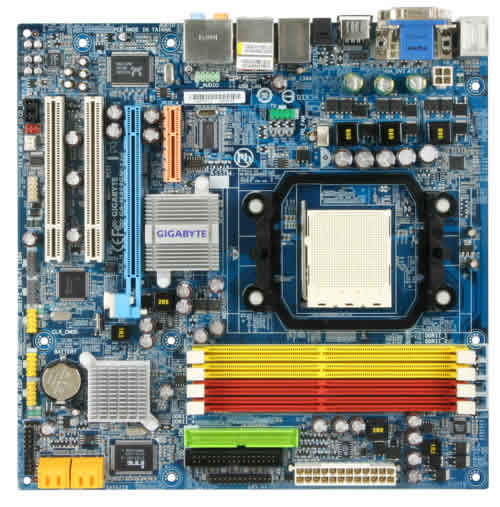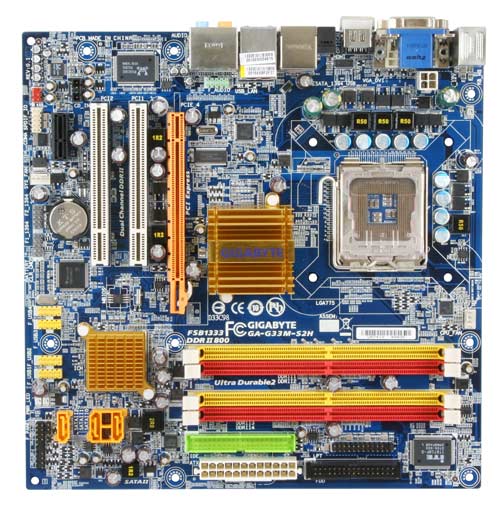Thursday, August 23
Matchingks!
Remember this?

Well, now it has a twin.

This is the GA-G33M-S2H. It uses Intel's G33 chipset for socket 775 CPUs (i.e. Core 2 Duo). It has much the same featureset as the socket AM2 GA-MA69GM-S2H: Up to 8GB of memory, four SATA 3Gb/s drives (including one eSATA port), 2 IDE drives, gigabit ethernet, twelve USB 2.0 ports and three Firewire ports; 7.1+2 sound and optical and coax S/PDIF in and out (with optional bracket); VGA, DVI-D and HDMI video outputs (though you can only run one digital and one analog output simultaneously); PCIe x16 and x1 slots and two PCI slots. And serial, parallel, floppy, keyboard and mouse, though you need to get optional brackets for the serial and parallel ports.
So now I'm looking at getting one each AMD and Intel; one for Windows and one for Linux, as I did back in 2003. But spending far less money for far faster systems.
The only problem is the shortage of SATA ports on these boards. I thought I'd found a cheap 2+2 port SATA/eSATA PCIe card, which would have solved that problem nicely. Turns out its more of a 2-2 card; it's really just a 2-port card with external sockets wired in parallel with the internal ones. Bleh. I can get a proper 2+2 card; HighPoint make them. But they cost twice as much as the motherboard itself, more even than this beastie:

Which has ten, count them, ten SATA ports (9 internal and one external). And two full PCIe x16 slots, and two PCI-X slots, and two PCIe x1 slots, and a PCI slot, and dual gigabit ethernet, and 10 USB, 2 Firewire, etc etc. It doesn't have built-in video, but this board plus a 512MB 8500GT is actually cheaper than the all-in-one board plus the HighPoint SATA card.
Comments are disabled.
Post is locked.
Remember this?

Well, now it has a twin.

This is the GA-G33M-S2H. It uses Intel's G33 chipset for socket 775 CPUs (i.e. Core 2 Duo). It has much the same featureset as the socket AM2 GA-MA69GM-S2H: Up to 8GB of memory, four SATA 3Gb/s drives (including one eSATA port), 2 IDE drives, gigabit ethernet, twelve USB 2.0 ports and three Firewire ports; 7.1+2 sound and optical and coax S/PDIF in and out (with optional bracket); VGA, DVI-D and HDMI video outputs (though you can only run one digital and one analog output simultaneously); PCIe x16 and x1 slots and two PCI slots. And serial, parallel, floppy, keyboard and mouse, though you need to get optional brackets for the serial and parallel ports.
So now I'm looking at getting one each AMD and Intel; one for Windows and one for Linux, as I did back in 2003. But spending far less money for far faster systems.
The only problem is the shortage of SATA ports on these boards. I thought I'd found a cheap 2+2 port SATA/eSATA PCIe card, which would have solved that problem nicely. Turns out its more of a 2-2 card; it's really just a 2-port card with external sockets wired in parallel with the internal ones. Bleh. I can get a proper 2+2 card; HighPoint make them. But they cost twice as much as the motherboard itself, more even than this beastie:

Which has ten, count them, ten SATA ports (9 internal and one external). And two full PCIe x16 slots, and two PCI-X slots, and two PCIe x1 slots, and a PCI slot, and dual gigabit ethernet, and 10 USB, 2 Firewire, etc etc. It doesn't have built-in video, but this board plus a 512MB 8500GT is actually cheaper than the all-in-one board plus the HighPoint SATA card.
Posted by: Pixy Misa at
03:40 AM
| Comments (3)
| Add Comment
| Trackbacks (Suck)
Post contains 303 words, total size 2 kb.
1
"Purplemonkeydishwasher!" is my response to all that. 
Posted by: kyer at Thursday, August 23 2007 01:29 PM (bLqh5)
2
Where's the 4th SATA port on that 2nd photo?
Posted by: Kean at Friday, August 24 2007 10:11 PM (+x+G7)
3
It's on the back panel - eSATA.
Posted by: Pixy Misa at Saturday, August 25 2007 12:33 AM (PiXy!)
48kb generated in CPU 0.0153, elapsed 0.1269 seconds.
56 queries taking 0.1163 seconds, 360 records returned.
Powered by Minx 1.1.6c-pink.
56 queries taking 0.1163 seconds, 360 records returned.
Powered by Minx 1.1.6c-pink.










